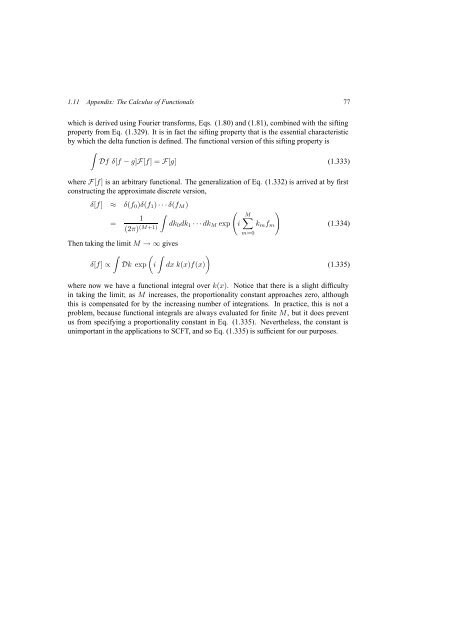Self-Consistent Field Theory and Its Applications by M. W. Matsen
Self-Consistent Field Theory and Its Applications by M. W. Matsen
Self-Consistent Field Theory and Its Applications by M. W. Matsen
You also want an ePaper? Increase the reach of your titles
YUMPU automatically turns print PDFs into web optimized ePapers that Google loves.
1.11 Appendix: The Calculus of Functionals 77<br />
which is derived using Fourier transforms, Eqs. (1.80) <strong>and</strong> (1.81), combined with the sifting<br />
property from Eq. (1.329). It is in fact the sifting property that is the essential characteristic<br />
<strong>by</strong> which the delta function is defined. The functional version of this sifting property is<br />
∫<br />
Df δ[f − g]F[f] =F[g] (1.333)<br />
where F[f] is an arbitrary functional. The generalization of Eq. (1.332) is arrived at <strong>by</strong> first<br />
constructing the approximate discrete version,<br />
δ[f] ≈ δ(f 0 )δ(f 1 ) ···δ(f M )<br />
∫<br />
( )<br />
1<br />
M∑<br />
=<br />
dk<br />
(2π) (M+1) 0 dk 1 ···dk M exp i k m f m (1.334)<br />
m=0<br />
Then taking the limit M →∞gives<br />
∫ ( ∫<br />
)<br />
δ[f] ∝ Dk exp i dx k(x)f(x)<br />
(1.335)<br />
where now we have a functional integral over k(x). Notice that there is a slight difficulty<br />
in taking the limit; as M increases, the proportionality constant approaches zero, although<br />
this is compensated for <strong>by</strong> the increasing number of integrations. In practice, this is not a<br />
problem, because functional integrals are always evaluated for finite M, but it does prevent<br />
us from specifying a proportionality constant in Eq. (1.335). Nevertheless, the constant is<br />
unimportant in the applications to SCFT, <strong>and</strong> so Eq. (1.335) is sufficient for our purposes.
















